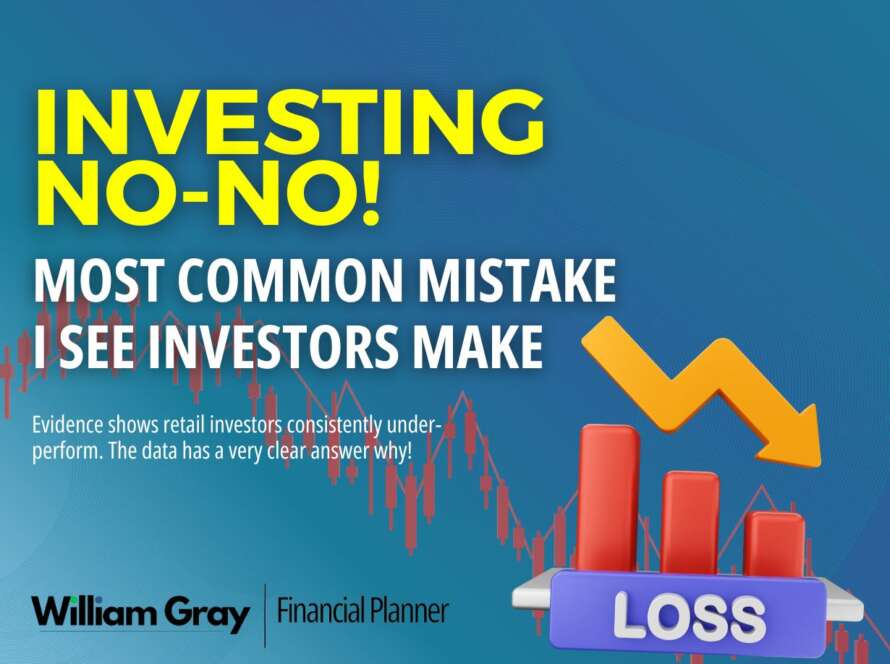Investing doesn’t have to feel like intimidating. As long as you have a solid plan walking into an investment, short-term volatility and “market noise” isn’t something to worry about. In this article, I’ll introduce some key concepts of investment for beginners to help you set the framework within which you can invest in a way that you are comfortable with.
Note that all investments can go up and down in value and nothing is ever guaranteed. Always seek professional financial advice before investing – and feel free to get in touch if you’d like a complimentary consultation with a professional financial adviser.
Understanding the risk premium
The first concept to understand is that of the risk premium. This is simply the additional return that you expect to earn for taking the risk of making an investment. This is calculated as any additional return over the “risk-free rate” which is the return of short-dated government bonds (which are generally considered risk-free). In plain English, the risk premium is what you’re getting paid for your investment above what you could get at the bank.
Understanding your risk profile
It’s essential to understand your risk profile when investing. This is made up of various components. First, your risk tolerance is a measure of how much risk you can tolerate without getting cold feet. Next, your risk capacity is how much risk you can objectively afford to take given your financial and other circumstances. Finally, your risk appetite is how much risk you desire (this could be an out of line with your risk capacity).
Knowing how much risk you should be taking will determine the types of investments you make.
Risk Diversification
It’s essential to diversify risk when investing. This means more than just holding more than one asset. Holding shares in 50 different tech companies is still not diversification and as it’s only one sector and thus the shares are likely to be correlated to one another. Holding multiple different types of assets, in different sectors and markets that are negatively correlated, is a more appropriate risk diversification strategy in investment for beginners.
Time Horizon
Your investment needs to have a goal beyond “to make more money”. A clear time horizon for your investment will determine what level of risk should be taken. For example, a 30-year-old investing for retirement at 60 can afford to wait out short-term market volatility, while someone saving to buy a house in 3 years time cannot afford to take as much risk as the money will be needed much sooner.
Outlining Your Goals
Further developing on the point of goals: you should have a clearly stated goal for your investments and treat each goal as a separate investment in itself — potentially by using accounts, segmenting funds within a single account, or by investing in different types of funds for different goals.
Oftentimes, your investment strategy will change as you approach your goal. This might mean switching into something much lower risk as you draw closer to taking the money out.
Investing vs Trading
Many people confuse these two things. Investments are for the long term — realistically nothing shorter than 5 years. Trading is a much shorter time horizon, involves much more risk, and most traders lose money over the long term. Investing is not about sitting in front of screens watching charts — it’s about planning, analysing fundamental value, and diversifying risk.
Assumptions in Investment for Beginners
The two most commonly used assumptions by investors are those of investment returns and future inflation. You can’t predict the future, but you should have some idea of what level of returns you’re expecting — this can help you to understand whether the returns you’re getting long-term are acceptable for the amount of risk taken. In some cases they may not be.
Benchmarking
All fund managers benchmark their fund, usually against an index of similar assets. This helps the fund manager and investor to see how the fund is performing against similar funds to it, and thus whether it is outperforming or underperforming. Benchmarking is essential to measure how well your investment is doing.

Understanding investment goals is key to a solid financial plan.
→ Types of Investments
Now we’ll have a look at some of the most commonly used types of investments.
Stocks & Shares
These two terms are used interchangeably and essentially mean the same thing. Company shares are generally the first thing that springs to mind when someone thinks of investing. Owning shares convey’s ownership in the underlying company itself and may also entitle the investor to a share of the company’s profits every year (this depends whether the company pays dividends to investors, or if it reinvests the money back into the company for further growth).
Owners of shares are usually allowed to vote on corporate governance issues at annual general meetings (AGMs), although some share classes don’t allow this.
Shares can be purchased through a brokerage account and are traded on stock exchanges around the world. Different companies are listed on different stock exchanges — sometimes in multiple countries, but usually just in one. Examples of major stock exchanges include the New York Stock Exchange (NYSE), the London Stock Exchange (LSE) and the Tokyo Stock Exchange (TSE).
Bonds
Bonds — both government bonds and corporate bonds — are debt that you can purchase to receive a (usually) lower-risk return that direct investment in shares. An example are US Treasury Bonds. The investor buys the bond which has a maturity date attached, often 5, 10, 15, 20, or 30 years. At this date, the investor receives their original investment back. They will have also received an interest payment, usually every six months, throughout the life of the bond.
Bonds can be held until maturity, or they can be traded on secondary markets.
Mutual Funds
Mutual funds come in all shapes and sizes and collectively pool lots of people’s money together to buy assets. This allows investors to gain exposure to a vast array of assets for a relatively low price per unit of the fund. Mutual funds are professionally managed by fund managers and will have their own risk rating, sustainability rating, and a stated objective and benchmark to measure performance against. As they are actively managed, they usually incur annual management fees to pay for the professionals and research overseeing them. This can be reassuring when considering investment as a beginner.
ETFs and ETCs
Exchange Traded Funds (ETFs) are a different structure of fund to a mutual fund. They trade directly on stock exchanges, whereas mutual funds sell units directly from the management company. ETFs generally track an index like the S&P500, the FTSE 100, or the MSCI World Index.
ETFs are usually passively managed, meaning they don’t try to beat the market, but rather simply follow it. For this reason, they tend to have lower annual management fees than mutual funds.
Exchange Traded Commodities (ETCs) are the same as ETFs but for commodities like gold, oil, wheat and silver.
REITs
Real Estate Investment Trusts (REITs) are a collective pool of investor’s money that generally purchases commercial real estate. They allow access to real estate investment for a significantly cheaper price than purchasing property outright, but they can have liquidity issues as it takes a long time to sell a property. For this reason, REITs can temporarily refuse investor withdrawals, especially when markets crash.
Structured Products
These come in many forms and can be high risk. Others are lower risk and capital protected (so long as the bank or institution issuing them doesn’t collapse). They often guarantee your initial investment and pay out extra if an underlying index performs in a pre-specified way. For example, you might invest $10,000 and get this back in 4 years, plus 20% on top of that if the S&P500 is more than 400 points higher than it is today.
Alternative Investments
This is a broad category that includes everything from art to fine wine to cryptocurrencies. Alternatives are an add-on to a portfolio and generally shouldn’t make up the core of the portfolio itself. They tend to be illiquid (meaning it’s difficult to sell them) or higher risk in the case of cryptocurrencies.
Hedge funds also fall under alternative investments and these are typically not accessible for less than a six-figure initial investment. It’s often illegal for hedge funds to market to the general public as they are specialist investments that often carry high risk due to gearing (leveraging using borrowing).

The world of alternative investments is complex and not for the faint hearted.
→ Risks in Investing
There are many types of risks in investing. Below we’ll go through some of them.
Market Risk
This is the risk of the price of an asset moving — both up and down — and the risk that the investor will ultimately get back less than what they put in.
Exchange Rate Risk
If you invest in USD but cash out in GBP, movements in exchange rates could affect your investment returns negatively or positively depending on how the currency rates moved.
Liquidity Risk
This refers to how easy it is to sell your asset. Stocks like Meta and Amazon are easy to sell, but smaller companies are not and the “spreads” can be wide, meaning you pay a high fee for selling. Property has high liquidity risk. Government bonds and blue chip stock tend to have very low liquidity risk.
Counterparty Risk
This is the risk that the party on the other side of a transaction goes broke. This is particularly risky in structured products and low quality bonds. Essentially it means the other side can’t afford to pay what they said they would and thus default on the payment.
Geopolitical risk
This is the risk that world events like war and sanctions can have on financial assets like stocks, currencies and bonds. One should avoid putting all their eggs in one basket to mitigate this.
There are many more types of risk to be aware of. It’s important to be aware of them when investing.

Geopolitical events like war can have a profound effect on markets around the world.
→ Factors Affecting Investment Returns
This depends on what the asset in question is. For companies, performance will depend on factors like company profits, the cost of production, the economic cycle, expectations on future performance of the company and its wider sector, and a little bit of luck!
The forces of supply and demand generally dictate the overall value of an asset, and thus any factor that makes it more desirable and in demand will likely have a positive impact on its price, and vice versa.
It’s important to always be aware that the price of an investment can go up as well as down. No investment is truly 100% risk free or guaranteed. You should only invest money that you can afford to lose and will not need in the immediate future. There are no free lunches, and if it’s too good to be true, then it probably is.
Always seek professional financial advice before investing. If you would like to book a complimentary consultation with myself (a professional financial adviser), then feel free to get in touch and I will be in contact.


